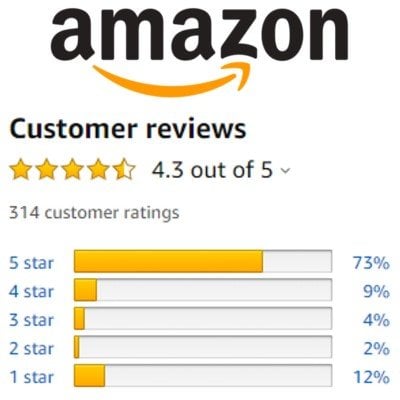Why You Shouldn’t Rely Solely on Amazon’s Review System
Amazon’s review system is a powerful tool for customers to share their experiences and opinions about products. However, it’s not foolproof. Fake reviews, biased ratings, and a lack of transparency can lead to poor purchasing decisions. In fact, a study found that up to 30% of Amazon reviews may be fake. This can result in customers buying low-quality products or missing out on better alternatives. To make informed purchasing decisions, it’s essential to look beyond Amazon’s review system and utilize third-party review-checking websites.
One of the primary concerns with Amazon’s review system is the prevalence of fake reviews. These can be created by manufacturers, sellers, or even individuals looking to manipulate the ratings. Fake reviews can be difficult to spot, but they often exhibit suspicious patterns, such as an unusually high number of reviews in a short period or over-the-top language. For instance, a product with 100 reviews in a single day, all with glowing praise, may indicate fake reviews.
Another issue with Amazon’s review system is biased ratings. Some reviewers may have a vested interest in promoting or demoting a product, which can skew the overall rating. For example, a reviewer who received a free product in exchange for a review may be more likely to leave a positive rating. Similarly, a reviewer who had a negative experience with a product may be more likely to leave a low rating, even if the product is generally well-regarded.
The lack of transparency in Amazon’s review system is also a concern. Reviewers are not required to disclose their relationship with the manufacturer or seller, which can make it difficult to determine the credibility of a review. Furthermore, Amazon’s algorithm for ranking reviews can be opaque, making it challenging to understand why certain reviews are displayed more prominently than others.
To overcome these limitations, it’s essential to use third-party review-checking websites. These websites can provide a more comprehensive and accurate picture of a product’s quality and performance. By utilizing these websites, customers can make more informed purchasing decisions and avoid the pitfalls of Amazon’s review system.
How to Spot Fake Reviews on Amazon: Red Flags to Watch Out For
When browsing Amazon reviews, it’s essential to be aware of the warning signs that may indicate a fake review. One common red flag is an unusually high number of reviews in a short period. For example, if a product has 100 reviews in a single day, it may be a sign that the reviews are fake. Another red flag is over-the-top language, such as reviews that use superlatives like “best product ever” or “life-changing.” These reviews may be exaggerated or even fabricated.
Unverified purchases are also a common indicator of fake reviews. If a reviewer has not purchased the product, they may not have first-hand experience with it. Look for reviews that are marked as “verified purchase” to ensure that the reviewer has actually used the product. Additionally, be wary of reviews that seem too similar or formulaic. Fake reviews may be copied and pasted from other sources or written using a template.
Let’s take the AmazonBasics Power Bank as an example. This product has a high rating on Amazon, but some reviews may be fake. Look for reviews that mention specific features or benefits of the product, such as its compact size or long battery life. Be skeptical of reviews that simply state that the product is “great” or “excellent” without providing any details.
Another way to spot fake reviews is to look for inconsistencies in the reviewer’s history. If a reviewer has only reviewed one product and has a history of leaving fake reviews, it may be a sign that their review is not trustworthy. You can use tools like Fakespot or ReviewMeta to analyze the reviewer’s history and detect potential fake reviews.
By being aware of these red flags, you can make more informed purchasing decisions and avoid falling victim to fake reviews. Remember to always read reviews critically and look for multiple sources before making a purchase.
Top Websites to Check Amazon Reviews: A Comprehensive Guide
When it comes to checking Amazon reviews, there are several third-party websites that can provide valuable insights and help you make informed purchasing decisions. These websites use advanced algorithms to analyze reviews and detect fake or biased ratings. Here are some of the top websites to check Amazon reviews:
Fakespot is a popular website that uses artificial intelligence to detect fake reviews on Amazon. It analyzes the reviewer’s history, the review’s content, and other factors to determine the likelihood of a review being fake. Fakespot also provides a grade for each product based on the authenticity of its reviews.
ReviewMeta is another website that provides detailed analysis of Amazon reviews. It uses a proprietary algorithm to detect fake reviews and provides a score for each product based on the quality of its reviews. ReviewMeta also allows users to filter reviews by rating, date, and other criteria.
Trustwerty is a website that provides a comprehensive analysis of Amazon reviews, including the reviewer’s history, the review’s content, and other factors. It also provides a score for each product based on the authenticity of its reviews. Trustwerty also allows users to compare reviews across different products and sellers.
These websites can be a valuable resource for anyone looking to check Amazon reviews and make informed purchasing decisions. By using these websites, you can get a more accurate picture of a product’s quality and performance, and avoid falling victim to fake or biased reviews.
When choosing a website to check Amazon reviews, consider the following factors:
Accuracy: Look for websites that use advanced algorithms to detect fake reviews and provide accurate analysis.
Comprehensiveness: Choose websites that provide detailed analysis of reviews, including the reviewer’s history and the review’s content.
Ease of use: Opt for websites that are easy to navigate and provide clear and concise information.
By using these factors to evaluate websites, you can find the best website to check Amazon reviews and make informed purchasing decisions.
What to Look for in a Review-Checking Website: Key Features to Consider
When choosing a website to check Amazon reviews, there are several key features to consider. These features can impact the accuracy and reliability of the reviews, as well as the overall user experience. Here are some of the most important features to look for:
Accuracy is a critical feature to consider when evaluating a review-checking website. Look for websites that use advanced algorithms to detect fake reviews and provide accurate analysis. For example, Fakespot uses a proprietary algorithm to detect fake reviews and provides a grade for each product based on the authenticity of its reviews.
Comprehensiveness is another important feature to consider. Look for websites that provide detailed analysis of reviews, including the reviewer’s history and the review’s content. ReviewMeta, for instance, provides a comprehensive analysis of reviews, including the reviewer’s history, the review’s content, and other factors.
Ease of use is also an essential feature to consider. Look for websites that are easy to navigate and provide clear and concise information. Trustwerty, for example, provides a user-friendly interface that makes it easy to find and analyze reviews.
Let’s take the Instant Pot Duo as an example. When researching this product, it’s essential to consider multiple sources and evaluate reviews critically. A review-checking website like Fakespot or ReviewMeta can provide valuable insights into the product’s quality and performance. By analyzing the reviews and ratings, you can get a more accurate picture of the product’s strengths and weaknesses.
When evaluating a review-checking website, consider the following factors:
Algorithm: Look for websites that use advanced algorithms to detect fake reviews and provide accurate analysis.
Data sources: Consider websites that use multiple data sources, including Amazon reviews, to provide a comprehensive analysis.
User interface: Opt for websites that are easy to navigate and provide clear and concise information.
By considering these factors, you can find a reliable website to check Amazon reviews and make informed purchasing decisions.
How to Use Review-Checking Websites to Make Informed Purchasing Decisions
Using review-checking websites is a crucial step in making informed purchasing decisions. By analyzing reviews and ratings, you can get a more accurate picture of a product’s quality and performance. Here’s a step-by-step guide on how to use review-checking websites:
Step 1: Choose a review-checking website. There are several websites to choose from, including Fakespot, ReviewMeta, and Trustwerty. Each website has its unique features and strengths, so it’s essential to choose one that meets your needs.
Step 2: Enter the product name or ASIN. Once you’ve chosen a review-checking website, enter the product name or ASIN to get started. This will bring up a list of reviews and ratings for the product.
Step 3: Analyze the reviews. Take a close look at the reviews and ratings for the product. Look for red flags, such as fake reviews or biased ratings. Also, pay attention to the overall rating and the number of reviews.
Step 4: Evaluate the reviews critically. Don’t just take the reviews at face value. Evaluate them critically, looking for patterns and inconsistencies. Also, consider the reviewer’s history and the review’s content.
Step 5: Consider multiple sources. Don’t rely on just one review-checking website. Consider multiple sources, including Amazon reviews, to get a more comprehensive picture of the product’s quality and performance.
By following these steps, you can use review-checking websites to make informed purchasing decisions. Remember to always evaluate reviews critically and consider multiple sources to get a more accurate picture of a product’s quality and performance.
For example, let’s say you’re considering purchasing the Anker Soundcore Flare 2. You can use a review-checking website like Fakespot to analyze the reviews and ratings for the product. By evaluating the reviews critically and considering multiple sources, you can get a more accurate picture of the product’s quality and performance.
Using review-checking websites is an essential step in making informed purchasing decisions. By following these steps, you can make more informed decisions and avoid costly mistakes.
Common Mistakes to Avoid When Using Review-Checking Websites
When using review-checking websites, there are several common mistakes to avoid. These mistakes can lead to inaccurate or incomplete information, which can ultimately impact purchasing decisions. Here are some common mistakes to avoid:
Relying too heavily on a single source. While review-checking websites can provide valuable insights, it’s essential to consider multiple sources to get a comprehensive picture of a product’s quality and performance. Relying too heavily on a single source can lead to biased or incomplete information.
Ignoring red flags. Review-checking websites often highlight red flags, such as fake reviews or biased ratings. Ignoring these red flags can lead to poor purchasing decisions. It’s essential to take these red flags seriously and consider them when evaluating a product.
Neglecting to read beyond the reviews. While reviews can provide valuable insights, it’s essential to read beyond the reviews to get a comprehensive picture of a product’s quality and performance. This includes reading the product description, checking the product’s specifications, and evaluating the seller’s reputation.
Not considering the reviewer’s history. Reviewers with a history of fake or biased reviews can impact the accuracy of the reviews. It’s essential to consider the reviewer’s history when evaluating reviews.
Not evaluating reviews critically. Reviews should be evaluated critically, considering the reviewer’s history, the review’s content, and other factors. This can help identify fake or biased reviews and provide a more accurate picture of a product’s quality and performance.
By avoiding these common mistakes, you can use review-checking websites effectively and make informed purchasing decisions. Remember to always consider multiple sources, evaluate reviews critically, and read beyond the reviews to get a comprehensive picture of a product’s quality and performance.
For example, let’s say you’re considering purchasing the Instant Pot Duo. You can use a review-checking website like Fakespot to analyze the reviews and ratings for the product. By avoiding common mistakes, such as relying too heavily on a single source or ignoring red flags, you can get a more accurate picture of the product’s quality and performance.
Maximizing Your Online Shopping Experience with Review-Checking Websites
Review-checking websites can significantly enhance the online shopping experience. By providing accurate and comprehensive information, these websites can help shoppers make informed purchasing decisions, saving time and avoiding costly mistakes. Here are some ways review-checking websites can maximize your online shopping experience:
Saving time. Review-checking websites can save shoppers a significant amount of time by providing a quick and easy way to evaluate products. By analyzing reviews and ratings, shoppers can quickly identify the best products and make informed purchasing decisions.
Avoiding costly mistakes. Review-checking websites can help shoppers avoid costly mistakes by identifying fake or biased reviews. By evaluating reviews critically, shoppers can avoid purchasing low-quality products and save money in the long run.
Discovering new products. Review-checking websites can also help shoppers discover new products. By analyzing reviews and ratings, shoppers can identify products that are highly rated and popular among other shoppers.
For example, let’s say you’re considering purchasing the Anker Soundcore Flare 2. You can use a review-checking website like Fakespot to analyze the reviews and ratings for the product. By evaluating the reviews critically, you can get a more accurate picture of the product’s quality and performance, and make an informed purchasing decision.
Review-checking websites can also provide additional benefits, such as:
Product recommendations. Review-checking websites can provide product recommendations based on your search history and preferences.
Price comparisons. Review-checking websites can provide price comparisons across different retailers, helping you find the best deals.
Product reviews from multiple sources. Review-checking websites can provide product reviews from multiple sources, giving you a more comprehensive picture of a product’s quality and performance.
By using review-checking websites, you can maximize your online shopping experience and make informed purchasing decisions. Remember to always evaluate reviews critically and consider multiple sources to get a comprehensive picture of a product’s quality and performance.
Staying Ahead of the Game: The Future of Review-Checking Websites
The future of review-checking websites is exciting and rapidly evolving. Emerging trends, technological advancements, and changes in consumer behavior are all shaping the review-checking landscape. Here are some potential developments that could impact the future of review-checking websites:
Artificial intelligence (AI) and machine learning (ML) will play a larger role in review-checking websites. AI and ML can help improve the accuracy and efficiency of review analysis, enabling review-checking websites to provide more reliable and comprehensive information.
The rise of voice commerce will also impact review-checking websites. As more consumers use voice assistants to make purchases, review-checking websites will need to adapt to provide seamless and intuitive experiences.
Blockchain technology may also be used to create more transparent and secure review-checking systems. Blockchain can help ensure the integrity of reviews and prevent fake or biased reviews from being posted.
Additionally, review-checking websites may incorporate more social media and influencer data to provide a more comprehensive picture of a product’s reputation and quality.
As the review-checking landscape continues to evolve, it’s essential to stay informed and adapt to changes. By staying ahead of the game, consumers can make more informed purchasing decisions and avoid costly mistakes.
For example, let’s say you’re considering purchasing a new smartwatch. You can use a review-checking website like Fakespot to analyze the reviews and ratings for the product. By staying informed about the latest trends and developments in review-checking technology, you can make a more informed purchasing decision and avoid costly mistakes.
In conclusion, the future of review-checking websites is exciting and rapidly evolving. By staying informed and adapting to changes, consumers can make more informed purchasing decisions and avoid costly mistakes.







